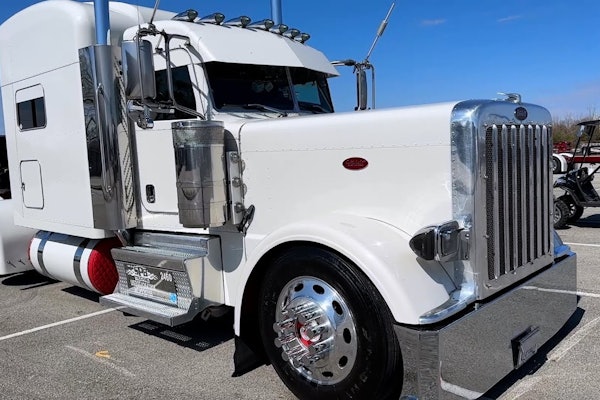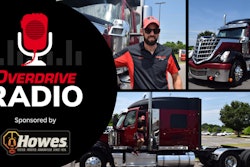Think of all the drivers a quarter of a century ago who thought their tractors were dream machine compared to the iron horses of the 1950s. Take a quantum leap forward to the modern technology available on 2002 models, which often sport cabs resembling cockpits of small airplanes.
Computers, global positioning satellite systems and driver-friendly controls have helped transform the industry to make a hard job a little easier for today’s trucker.
Split-second calculations
Back in 1977 about the closest thing to an engine computer you could find was an improved mechanical governor in the injection pump or unit injector system. It had been radically changed by all the manufacturers to produce “torque-rise,” which meant engines that pulled better when lugged down than traditional diesels. The result was reduced shifting, especially when climbing grades.
Today there is a computer on the engine in place of the mechanical governor. It’s an electronic microprocessor that can make thousands of calculations a second. It was put there to increase the precision and flexibility of the injection system to help meet emissions standards. But, as everyone soon found out, putting it on the truck was like Pandora opening her box. That’s because one of electronics’ greatest advantages is its programmability-you can tell the computer to solve any problem, and therefore perform any function that you can provide hardware for.

In the ’70s, the driver’s foot moved a lever on the pump governor with the throttle pedal and a cable. Now, the throttle pedal only changes an electronic signal sent to the computer. That makes the throttle action very smooth and precise.
But engine computers do a whole lot more.
Super Cruisin’
One of the best examples is modern cruise control. You could get cruise control in 1977, but it was an aftermarket system with little electronic sophistication. As a result, it reacted roughly to changes in grades, causing uneven bursts of engine power, and it was unreliable. Today’s ECM controls how much fuel the engine’s injectors pump in and it reads truck speed off a speed sensor on the back of the transmission. Today’s cruise control, smooth and reliable, is just a function programmed into the engine ECM. There’s no separate hardware except some simple switches. And these days your cruise control can be integrated with other systems.
One such connection, says Bill Gouse, vice president of engineering at the American Trucking Associations, is a sonar system called Eaton Vorad. It’s biggest job is to warn the driver in fog or other low visibility conditions when he’s approaching a vehicle ahead at too fast a speed or following too closely. It sends high frequency radio waves out in front of the truck and measures what comes back. If there is something ahead, it can figure out the distance and how fast it is moving.
Vorad also reads vehicle speed from the engine computer and then integrates that information with the speed difference and distance between the two vehicles. It considers the speeds involved before warning the driver.
But it also has another function. This, says Gouse, is its “active cruise” function. It adjusts the cruise setting downward when a truck whose cruise control is set for 65 mph encounters another vehicle ahead doing, say, 62 mph. The speeds of the two vehicles will quickly match, and at a following distance that is appropriate for the speed. The driver can continue running without resetting the cruise speed.
Among other big technology leaps forward, Ralph DeGenova, marketing manager at Volvo Trucks North America, cites the variable power curves modern engine computers can handle. Fleets have never been eager to spec maximum power in a truck engine without some kind of speed limiting. Drivers too often use that power to quickly reach and hold higher speeds that waste fuel. Modern engine computers can rate the engine at, say, 430 horsepower normally, then boost it up to 500 hp when in cruise control. The cruise control’s range can be restricted so it can’t be set above the fleet’s approved maximum speed, say 65 mph. When the driver sets the cruise, his engine suddenly climbs hills with 500 horses, minimizing shifting and improving the performance of his vehicle without wasting a lot of fuel. This system, too, has no separate hardware.
Other such electronic integration saves novice and experienced drivers alike embarrassing and expensive moments. DeGenova points out that, for example, on a dump truck, the PTO can be integrated with the transmission. This way, once the driver shifts out of the lowest gears, the PTO disengages and he won’t ever be running down the road at 55 mph as the dump body rises to meet a bridge.
The driver message display on the Mack Vision tractor uses a high-contrast display made by Planar Systems. A tremendous amount of research went into making it possible to read the display in less than two seconds, so the driver can maintain his view of the highway.
Doing the Math
Frank Bio, Volvo’s marketing manager for Volvo Link, says another major advance from the late ’70s is the total electronic integration that has occurred in the dash. Instruments are now most often operated via coded multiplexing signals, not with separate wires to each. More processors have been added to the truck in various locations.
Says Gouse, “People throughout the industry are now working hard to integrate all this into one output for the driver.” The result is an integrated message center on the dash in many trucks. For example, a driver can be sent an early warning that the engine temperature is starting to rise out of the normal operating range. He will receive a red light indicating oil pressure is dropping, not just a gauge indication that he might not see with his eyes on the road most of the time.
Doing all this offers hardware challenges, and also means developing software. Gouse adds, “One of today’s challenges is automatically feeding the driver information using an intelligent hierarchy.” That is, the information must come in the right order, so “Engine Overheating” will show up before “Low Fuel.”
Another aspect of this is the science of legibility. Truck manufacturers want the driver to be able to read critical warnings in what is termed a “safe glance time” of less than two seconds. Displays are designed with very high contrast levels and letters of appropriate size so the driver can read a message quickly. The display is also positioned so the driver’s eyes don’t have to look too far downward. The result is safer and easier retrieval of important information.
Many trucks today also have mapping software which Gouse says, “is getting better and better. It really helps when the driver is looking for the right road. He used to be sitting there looking through a trucker’s atlas, and would often end up going the wrong way down a one-way street. That doesn’t happen as often any more.”
Pampering Power
Not all the changes that have occurred in the truck cab have been created purely to make the driver more productive. Many relieve the tedium of adjusting things while driving. As an example, Gouse cites satellite radio, where “a driver can listen to one radio station while crossing the country, rather than re-tuning the radio 30 or more times during the trip.” Then there’s been the development of electronic climate control. “The driver can leave Crater Lake, Ore., in the early morning with an outside temperature of 10 degrees and arrive in Sacramento in the afternoon with the atmosphere at 100 degrees. With the cab climate control set at 72 degrees, he will experience the same in-cab temperature without even having to touch a knob,” he reports.
Driver Communications
For many drivers, the satellite communications systems developed during the 1990s changed life in the cab forever. Chris Wolfe, president of Qualcomm Wireless Business Solutions, says “Weeks on the road often make a truck driver feel isolated. With satellite communications, he can be only a keystroke away from help, as well as less critical communication.”
One of the classic examples of how these systems help drivers occurred last September. Says Wolfe, “Schneider National had 18 trucks in Manhattan on 9/11. The fleet messaged the drivers about what was going on and got them all out. They also messaged a number of trucks heading there, and kept them from going in.”
Qualcomm OmniTRACS systems are now used on 250,000 trucks in North America. “The driver’s initial perspective was one of distrusting a device that reminded him of Big Brother,” Wolfe admits. But soon, he reports, because of that ability to send data and both business and personal messages, “drivers saw it as a way to get more loads and improve their quality of life. It can even be used to resolve things like pay issues.” The latter is possible because the system is often integrated with a fleet’s payroll system. It can be used to send settlement sheets in so the driver doesn’t have to wait to report his miles.
More and more drivers today carry laptops, cell phones and other electronic devices for business and staying in touch with home. Twenty-five years ago, the pay phone was the basic link to employer, friends and family.
A Sweet 16 Date
A “panic button” can be added to allow a driver to instantly signal his dispatcher he’s in need of immediate help, if, for example, he’s being hijacked or having a heart attack.
“Say a driver needs to be home in three weeks for his daughter’s 16th birthday,” says Wolfe. “His request is integrated into the system’s dispatch planning system. Its optimization software will route him based on load availability so he’ll be home on time.” Such feats are sometimes accomplished through “swap and drop” arrangements where the system can find two trucks headed in opposite directions and allow the drivers to swap trailers.
Volvo introduced Volvo Link satellite communications system to the world a few months ago. Frank Bio says a driver can push a couple of buttons on the end of the turn signal stalk to scroll to the right screen of the Driver Message Center already on the dash when he wants to use the system.
“Messages will only be displayed at lower speeds, and the driver can’t retrieve more than a single message till he stops. It’s easy to use the system’s simple, integral controls to create brief, basic messages like “load will be delivered one hour late.”
The system is so sophisticated, says Bio, it will be able to transmit engine trouble codes back to the fleet’s base of operations, allowing the driver to get the truck to a service outlet before it breaks down.
Workload Relief
What all this comes down to is scads of information the driver can use to make his life easier and increase his professionalism through what Gouse terms “relief of workload.” We’re talking about relief from tedious events like mis-routings and breakdowns. Or knowing in plenty of time that a receiver needs to receive your load an hour late so you can just slow down and save fuel and personal energy. Or knowing where your next load will come from so you don’t have to lay over.
The 2002 driver is more comfortable while driving, but also runs smarter. Running smarter increases the income he receives while often reducing the effort he needs to make to earn that income. For many drivers, 1977 might have been a great year, but it was a lot harder work behind the wheel.








